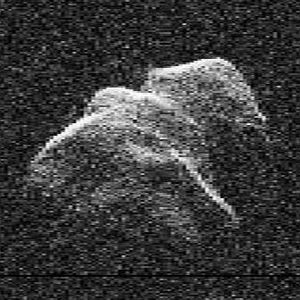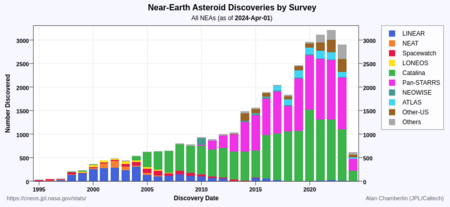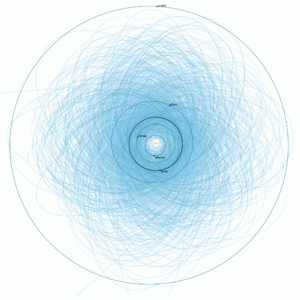Potentially hazardous object facts for kids

A potentially hazardous object (PHO) is a space rock, like an asteroid or a comet, that comes close to Earth. These objects are big enough to cause a lot of damage if they ever hit our planet. Scientists call them "potentially hazardous" if their path brings them very close to Earth. This means they pass within about 7.5 million kilometers (4.6 million miles) of Earth's orbit. They also need to be larger than about 140 meters (460 feet) across.
Good news! More than 99% of all known potentially hazardous objects are not expected to hit Earth in the next 100 years. As of July 2025, only 21 known PHOs are still being watched closely for possible future threats. Over many hundreds or thousands of years, the paths of some of these asteroids can change. This means they might become a real threat in the very distant future.
Most of these objects are potentially hazardous asteroids (PHAs). A few are comets. As of November 2022, there are 2,304 known PHAs. This is about 8% of all near-Earth objects. About 153 of these are thought to be larger than one kilometer (0.6 miles) wide. Many discovered PHAs are Apollo asteroids. Fewer are Aten asteroids.
If we know an object's orbit well, we can be sure it won't hit Earth for at least 100 years. Potentially hazardous asteroids that might hit Earth in the next 100 years are listed on a special "Sentry Risk Table." As of September 2022, only 17 PHAs were on this list. Scientists keep observing new discoveries to learn more about their paths. Thanks to many astronomical surveys, the number of known PHAs has grown a lot since the late 1990s. NASA astronomers said in May 2021 that it could take 5 to 10 years to prepare if we ever need to stop a potential impact.
Contents
What are Potentially Hazardous Objects?
An object is a PHO if its closest approach to Earth's orbit is less than about 7.5 million kilometers (4.6 million miles). This distance is roughly 19.5 times the distance from Earth to the Moon. Also, the object must be brighter than a certain level, which usually means it's larger than 140 meters (460 feet) across.
An object this size could cause huge damage to cities or even a large tsunami if it hit the ocean. Such impacts happen on average about once every 10,000 years. Scientists estimate there are about 4,700 potentially hazardous asteroids larger than 100 meters (330 feet).
How We Measure Hazard
Scientists use two main scales to measure how dangerous an asteroid impact might be. These are called the Torino scale and the Palermo scale. They help us understand the risk.
Potentially Hazardous Comets
A potentially hazardous comet (PHC) is a comet that comes very close to Earth. This means its path brings it within about 7.5 million kilometers of Earth's orbit. Some known PHCs include 109P/Swift-Tuttle and 55P/Tempel–Tuttle. Halley's Comet used to fit this rule before the year 837. It passed very close to Earth then. Now, its closest approach is farther away.
How Many Are There?

| LINEAR NEAT Spacewatch LONEOS CSS |
Pan-STARRS NEOWISE ATLAS Others |
In 2012, NASA thought that only 20 to 30 percent of these objects had been found. When an asteroid passes close to a planet, the planet's gravity can change the asteroid's path. This means an asteroid that wasn't a threat before could become one, or vice versa. This shows how much the Solar System is always changing.
Many astronomical survey projects are still looking for more PHOs. These include Lincoln Near-Earth Asteroid Research, Catalina Sky Survey, and Pan-STARRS. When a new PHO is found, scientists study it. They use tools like telescopes, radar, and infrared sensors. This helps them figure out its size, what it's made of, how fast it spins, and its exact orbit. Both professional and amateur astronomers help with this important work.
How Big Are They?
Asteroids larger than about 35 meters (115 feet) can be a threat to a town or city. But it's hard to know the exact size of most small asteroids. Scientists usually guess their size based on how bright they appear and how far away they are. They don't often measure them directly with radar. Because of this, NASA and the Jet Propulsion Laboratory use a measure called absolute magnitude (H). Any asteroid with an absolute magnitude of 22.0 or brighter is thought to be large enough to be a PHO.
It's only a rough guess of size from an object's brightness. This is because we have to guess how reflective its surface is. NASA's near-Earth object program assumes a reflectivity of 0.14 for this.
Largest Potentially Hazardous Asteroids
The largest known potentially hazardous object is likely the Apollo asteroid (53319) 1999 JM8. It is about 7 kilometers (4.3 miles) wide. Its brightness is 15.2. Keep in mind that the sizes in the table below are estimates. They are based on how bright the object is and how reflective we think it is.
| Name | Discovery | (H) (mag) |
D (km) |
Orbital description | Remarks | References | ||||||||
|---|---|---|---|---|---|---|---|---|---|---|---|---|---|---|
| Year | Place | Discoverer | Class | a (AU) |
e | i (°) |
q (AU) |
Q (AU) |
MOID (AU) |
|||||
| [[(4953) 1990 MU{{{2}}}|(4953) 1990 MU{{{2}}}]] | 1990 | 413 | R. H. McNaught | 14.1 | 3 | APO | 1.621 | 0.658 | 24.4 | 0.555 | 2.687 | 0.02640 | — | MPC · JPL · catalog |
| 3122 Florence | 1981 | 413 | S. J. Bus | 14.1 | 5 | AMO | 1.769 | 0.423 | 22.2 | 1.020 | 2.518 | 0.04430 | — | MPC · JPL · catalog |
| (16960) 1998 QS52 | 1998 | 704 | LINEAR | 14.3 | 4 | APO | 2.203 | 0.858 | 17.5 | 0.313 | 4.093 | 0.01443 | — | MPC · JPL · catalog |
| 4183 Cuno | 1959 | 074 | C. Hoffmeister | 14.4 | 4 | APO | 1.982 | 0.634 | 6.7 | 0.725 | 3.240 | 0.02825 | — | MPC · JPL · catalog |
| 3200 Phaethon | 1983 | 500 | IRAS | 14.6 | 5.8 | APO | 1.271 | 0.890 | 22.3 | 0.140 | 2.402 | 0.01945 | — | MPC · JPL · catalog |
| (242450) 2004 QY2 | 2004 | E12 | Siding Spring Survey | 14.7 | 3 | APO | 1.084 | 0.477 | 37.0 | 0.567 | 1.601 | 0.04686 | — | MPC · JPL · catalog |
| [[(89830) 2002 CE{{{2}}}|(89830) 2002 CE{{{2}}}]] | 2002 | 704 | LINEAR | 14.9 | 3.1 | AMO | 2.077 | 0.507 | 43.7 | 1.023 | 3.131 | 0.02767 | — | MPC · JPL · catalog |
| (137427) 1999 TF211 | 1999 | 704 | LINEAR | 15.1 | 2.9 | APO | 2.448 | 0.610 | 39.2 | 0.955 | 3.942 | 0.01787 | — | MPC · JPL · catalog |
| (111253) 2001 XU10 | 2001 | 704 | LINEAR | 15.2 | 3 | APO | 1.754 | 0.439 | 42.0 | 0.983 | 2.524 | 0.02934 | — | MPC · JPL · catalog |
| (53319) 1999 JM8 | 1999 | 704 | LINEAR | 15.2 | 7 | APO | 2.726 | 0.641 | 13.8 | 0.978 | 4.474 | 0.02346 | Likely largest PHO | MPC · JPL · catalog |
| 1981 Midas | 1973 | 675 | C. T. Kowal | 15.2 | 2 | APO | 1.776 | 0.650 | 39.8 | 0.621 | 2.931 | 0.00449 | — | MPC · JPL · catalog |
| 2201 Oljato | 1947 | 690 | H. L. Giclas | 15.25 | 2.1 | APO | 2.175 | 0.713 | 2.5 | 0.624 | 3.726 | 0.00305 | — | MPC · JPL · catalog |
| (90075) 2002 VU94 | 2002 | 644 | NEAT | 15.3 | 2.2 | APO | 2.134 | 0.576 | 8.9 | 0.904 | 3.363 | 0.03010 | — | MPC · JPL · catalog |
| 4179 Toutatis | 1989 | 010 | C. Pollas | 15.30 | 2.5 | APO | 2.536 | 0.629 | 0.4 | 0.940 | 4.132 | 0.00615 | — | MPC · JPL · catalog |
| (159857) 2004 LJ1 | 2004 | 704 | LINEAR | 15.4 | 3 | APO | 2.264 | 0.593 | 23.1 | 0.920 | 3.607 | 0.01682 | — | MPC · JPL · catalog |
| (85713) 1998 SS49 | 1998 | 704 | LINEAR | 15.6 | 3.5 | APO | 1.924 | 0.639 | 10.8 | 0.694 | 3.154 | 0.00234 | — | MPC · JPL · catalog |
| 4486 Mithra | 1987 | 071 | E. W. Elst V. G. Shkodrov |
15.6 | 2 | APO | 2.200 | 0.663 | 3.0 | 0.742 | 3.658 | 0.04626 | — | MPC · JPL · catalog |
| 1620 Geographos | 1951 | 675 | A. G. Wilson R. Minkowski |
15.60 | 2.5 | APO | 1.245 | 0.335 | 13.3 | 0.828 | 1.663 | 0.03007 | — | MPC · JPL · catalog |
| (415029) 2011 UL21 | 2011 | 703 | CSS | 15.7 | 2.5 | APO | 2.122 | 0.653 | 34.9 | 0.736 | 3.509 | 0.01925 | — | MPC · JPL · catalog |
| (242216) 2003 RN10 | 2003 | 699 | LONEOS | 15.7 | 2.5 | AMO | 2.231 | 0.541 | 39.6 | 1.024 | 3.438 | 0.00956 | — | MPC · JPL · catalog |
| 12923 Zephyr | 1999 | 699 | LONEOS | 15.8 | 2 | APO | 1.962 | 0.492 | 5.3 | 0.996 | 2.927 | 0.02115 | — | MPC · JPL · catalog |
| (52768) 1998 OR2 | 1998 | 566 | NEAT | 15.8 | 2 | APO | 2.380 | 0.573 | 5.9 | 1.017 | 3.743 | 0.01573 | — | MPC · JPL · catalog |
PHA Discoveries Over Time
Here is a list of the brightest PHAs found each year since 1989. The charts below show how many PHAs have been discovered over time. One chart shows the total number. The other shows only those larger than one kilometer. PHAs brighter than absolute magnitude 17.75 are likely larger than 1 kilometer.
| Number | Name | Year | (H) | Refs |
|---|---|---|---|---|
| 4179 | Toutatis | 1989 | 15.3 | MPC · JPL · catalog |
| 4953 | 49531990 MU | 1990 | 14.9 | MPC · JPL · catalog |
| 7341 | [[1991 VH{{{2}}}|1991 VH{{{2}}}]] | 1991 | 17.0 | MPC · JPL · catalog |
| 10115 | [[1992 SK{{{2}}}|1992 SK{{{2}}}]] | 1992 | 17.2 | MPC · JPL · catalog |
| 39572 | 395721993 DQ | 1993 | 16.6 | MPC · JPL · catalog |
| 7482 | 74821994 PC | 1994 | 16.7 | MPC · JPL · catalog |
| 243566 | 2435661995 SA | 1995 | 17.4 | MPC · JPL · catalog |
| 8566 | 85661996 EN | 1996 | 16.3 | MPC · JPL · catalog |
| 35396 | 1997 XF11 | 1997 | 17.0 | MPC · JPL · catalog |
| 16960 | 169601998 QS | 1998 | 14.4 | MPC · JPL · catalog |
| 137427 | 1374271999 TF | 1999 | 15.3 | MPC · JPL · catalog |
| 138095 | 1380952000 DK | 2000 | 16.0 | MPC · JPL · catalog |
| 111253 | 1112532001 XU | 2001 | 15.3 | MPC · JPL · catalog |
| 89830 | 898302002 CE | 2002 | 15.0 | MPC · JPL · catalog |
| 242216 | 2422162003 RN | 2003 | 15.7 | MPC · JPL · catalog |
| 242450 | 2424502004 QY | 2004 | 14.6 | MPC · JPL · catalog |
| 308242 | 3082422005 GO | 2005 | 16.3 | MPC · JPL · catalog |
| 374851 | 3748512006 VV | 2006 | 16.7 | MPC · JPL · catalog |
| 214869 | 2148692007 PA | 2007 | 16.5 | MPC · JPL · catalog |
| 294739 | 2947392008 CM | 2008 | 17.1 | MPC · JPL · catalog |
| 523630 | 5236302009 OG | 2009 | 16.2 | MPC · JPL · catalog |
| 458122 | 3819062010 EW | 2010 | 17.6 | MPC · JPL · catalog |
| 415029 | 4150292011 UL | 2011 | 15.9 | MPC · JPL · catalog |
| 746849 | 2012 HJ1 | 2012 | 17.9 | MPC · JPL · catalog |
| 507716 | 5077162013 UP | 2013 | 16.4 | MPC · JPL · catalog |
| 533671 | 2014 LJ21 | 2014 | 16.1 | MPC · JPL · catalog |
| – | 2015 HY116 | 2015 | 17.6 | MPC · JPL · — |
| 620095 | 2016 CB194 | 2016 | 17.6 | MPC · JPL · catalog |
| – | 2017 CH1 | 2017 | 17.9 | MPC · JPL · — |
| 756316 | 2018 XV5 | 2018 | 17.7 | MPC · JPL · catalog |
| – | 2019 RU3 | 2019 | 18.1 | MPC · JPL · — |
| – | 2020 SL1 | 2020 | 17.7 | MPC · JPL · — |
| – | 2021 HK12 | 2021 | 17.7 | MPC · JPL · — |
| – | 2022 AP7 | 2022 | 17.3 | MPC · JPL · — |
| – | 2023 QF5 | 2023 | 18.3 | MPC · JPL · — |
| – | 2024 YU4 | 2024 | 19.0 | MPC · JPL · — |
Images for kids
See also
- Asteroid impact avoidance
- Earth-grazing fireball
- Global catastrophic risk
- List of asteroid close approaches to Earth
- Scout (NASA program); short term warnings
- Sentry (monitoring system)
- Spaceguard



